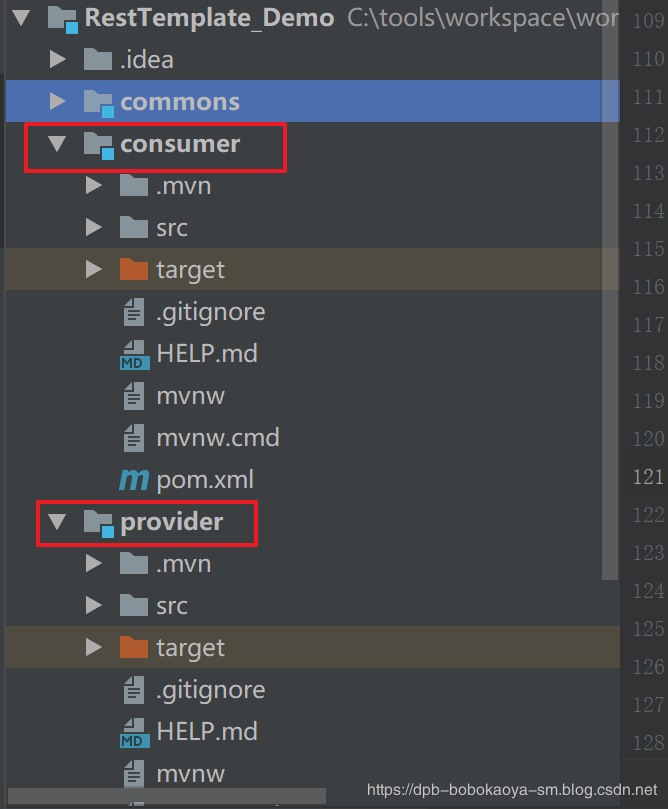您好,登錄后才能下訂單哦!
您好,登錄后才能下訂單哦!
如何正確的使用Spring RestTemplate?針對這個問題,這篇文章詳細介紹了相對應的分析和解答,希望可以幫助更多想解決這個問題的小伙伴找到更簡單易行的方法。
1.環境搭建
??為了演示RestTemplate的使用,我們創建兩個SpringBoot項目,一個provider作為server端,一個consumer作為服務調用方法

2.API方法介紹
| API | 說明 |
|---|---|
| getForEntity() | 發送一個HTTP GET請求,返回的ResponseEntity包含了響應體所映射成的對象 |
| getForObject() | 發送一個HTTP GET請求,返回的請求體將映射為一個對象 |
| postForEntity() | POST 數據到一個URL,返回包含一個對象的ResponseEntity,這個對象是從響應體中映射得到的 |
| postForObject() | POST 數據到一個URL,返回根據響應體匹配形成的對象 |
| headForHeaders() | 發送HTTP HEAD請求,返回包含特定資源URL的HTTP頭 |
| optionsForAllow() | 發送HTTP OPTIONS請求,返回對特定URL的Allow頭信息 |
| postForLocation() | POST 數據到一個URL,返回新創建資源的URL |
| put() | PUT 資源到特定的URL |
| delete() | 在特定的URL上對資源執行HTTP DELETE操作 |
| exchange() | 在URL上執行特定的HTTP方法,返回包含對象的ResponseEntity,這個對象是從響應體中映射得到的 |
| execute() | 在URL上執行特定的HTTP方法,返回一個從響應體映射得到的對象 |
3.具體使用
??我們通過常用的http協議的四種請求方式來看下效果
3.1 無參請求
??我們先來看下服務端請求方法不需要接收參數,
getForEntity
??通過getForEntity來實現
服務端
/**
* 無參,返回字符串
* @return
*/
@GetMapping("/server1")
public String server1String(){
System.out.println("服務端被訪問了...");
return "success";
}調用
/**
* RestTemplate 訪問 provider的第一個服務 server1
*/
@Test
public void contextLoads() {
String url = "http://localhost:8080/server1";
RestTemplate restTemplate = new RestTemplate();
ResponseEntity<String> entity = restTemplate.getForEntity(url, String.class);
// 獲取響應的狀態
HttpStatus statusCode = entity.getStatusCode();
// 獲取響應的header信息
HttpHeaders headers = entity.getHeaders();
// 獲取響應的body信息
String msg = entity.getBody();
System.out.println(statusCode);
System.out.println(headers);
System.out.println(msg);
}輸出結果

說明:
1.getForEntity()方法執行返回的類型是ResponseEntity<T>,ResponseEntity<T>是Spring對HTTP請求響應的封裝,包括了幾個重要的元素,如響應碼、contentType、contentLength、響應消息體等,在輸出結果中我們能夠看到
2.getForEntity()的參數中第一個是請求地址,第二個是T對應的類型
getForObject
??getForObject函數實際上是對getForEntity函數的進一步封裝,如果你只關注返回的消息體的內容,對其他信息都不關注,此時可以使用getForObject
/**
* getForObject 訪問
*/
@Test
public void contextLoadsObject() {
String url = "http://localhost:8080/server1";
RestTemplate restTemplate = new RestTemplate();
// 直接返回的就是我們需要的結果,但是獲取不到對應的響應狀態等信息
String msg = restTemplate.getForObject(url,String.class);
System.out.println(msg);
}3.2 有參請求
服務端方法需要接收調用者傳遞的參數
/**
* 有參,基本數據類型 返回字符串
* @return
*/
@RequestMapping("/server2")
public String server2String(Integer id,String userName){
System.out.println("服務端被訪問了..."+id+" "+userName);
return "success--參數得到了";
}
/**
* 有參,基本數據類型 返回字符串
* @return
*/
@RequestMapping("/server3")
public String server3String(User user){
System.out.println("服務端被訪問了..."+user);
return "success--參數得到了";
}getForEntity
調用者可以通過兩種方式調用
第一種方式通過數字占位符,最后是一個可變長度的參數,來一一替換前面的占位符
/**
* 請求服務并且傳遞參數
* 基本數據類型
*/
@Test
public void testServer2(){
// 參數在鏈接地址后
String url = "http://localhost:8080/server2?id={1}&userName={2}";
RestTemplate restTemplate = new RestTemplate();
ResponseEntity<String> entity = restTemplate.getForEntity(url, String.class,5,"bobo");
System.out.println(entity.getBody());
}第二種就是使用name={name}這種形式,最后一個參數是一個map,map的key即為前邊占位符的名字,map的value為參數值
/**
* 請求服務并且傳遞參數
* 基本數據類型
*/
@Test
public void testServer3(){
String url = "http://localhost:8080/server2?id={id}&userName={userName}";
Map<String,Object> map = new HashMap<>();
map.put("id",6);
map.put("userName","波波烤鴨");
RestTemplate restTemplate = new RestTemplate();
ResponseEntity<String> entity = restTemplate.getForEntity(url, String.class,map);
System.out.println(entity.getBody());
}postForEntity
??如果是post方式提交請求傳遞參數我們可以這樣使用,如下
服務端:注意要加@RequestBody注解
/**
* 有參,基本數據類型 返回字符串
* @return
*/
@RequestMapping("/server3")
public String server3String(@RequestBody User user){
System.out.println("服務端被訪問了..."+user);
return "success--參數得到了";
}客戶端
/**
* postForEntity(url,user,String.class)
* url:請求地址
* user:請求提交的數據
* String.class 接收返回數據的類型
*/
@Test
public void contextLoadsObject1() {
String url = "http://localhost:8080/server3";
RestTemplate restTemplate = new RestTemplate();
User user = new User(1,"bobo","中國");
// 直接返回的就是我們需要的結果,但是獲取不到對應的響應狀態等信息
String msg = restTemplate.postForEntity(url,user,String.class).getBody();
System.out.println(msg);
}3.3 返回自己類型
服務端返回的我們自定義類型的數據
/**
* 返回自定義對象
* @return
*/
@RequestMapping("/server4")
public User server4Object(){
System.out.println("服務端被訪問了...");
return new User(2,"李四","深圳");
}客戶端:
/**
* 返回類型為自定義類型
*/
@Test
public void testServer5(){
String url = "http://localhost:8080/server4";
RestTemplate restTemplate = new RestTemplate();
ResponseEntity<User> entity = restTemplate.getForEntity(url, User.class);
System.out.println(entity.getBody());
}使用getForEntity和getForObject及postForEntity和postForObject都差不多,注意接收的類型即可。
3.4 返回的list帶泛型的場景
此處我們需要使用到exchange方法,特定如下
允許調用者指定HTTP請求的方法(GET,POST,PUT等)
可以在請求中增加body以及頭信息,其內容通過參‘HttpEntity<?>requestEntity'描述
exchange支持‘含參數的類型'(即泛型類)作為返回類型,該特性通過‘ParameterizedTypeReferenceresponseType'描述
客戶端調用
/**
* 返回 集合帶泛型
* @return
*/
@RequestMapping("/server5")
public List<User> server5List(){
System.out.println("服務端被訪問了...");
return Arrays.asList(new User(2,"李四1","深圳")
,new User(3,"李四2","深圳")
,new User(4,"李四3","深圳"));
}
關于如何正確的使用Spring RestTemplate問題的解答就分享到這里了,希望以上內容可以對大家有一定的幫助,如果你還有很多疑惑沒有解開,可以關注億速云行業資訊頻道了解更多相關知識。
免責聲明:本站發布的內容(圖片、視頻和文字)以原創、轉載和分享為主,文章觀點不代表本網站立場,如果涉及侵權請聯系站長郵箱:is@yisu.com進行舉報,并提供相關證據,一經查實,將立刻刪除涉嫌侵權內容。